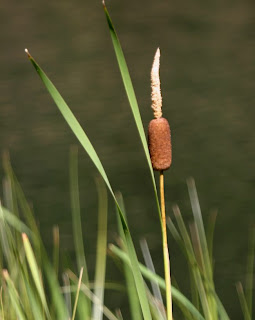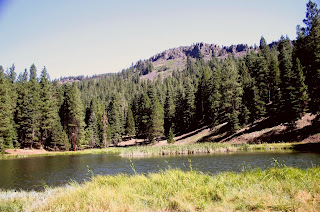 On this Eastern Oregon trip, when I got to Baker City, Oregon, I had a mission in mind-- to find the grave of the man pictured above-- my great grandfather. I have never driven through Baker City without thinking about doing this. With only knowing my great grandfather's name, the approximate year of his death, the Internet provided the name of the most likely cemetery.
On this Eastern Oregon trip, when I got to Baker City, Oregon, I had a mission in mind-- to find the grave of the man pictured above-- my great grandfather. I have never driven through Baker City without thinking about doing this. With only knowing my great grandfather's name, the approximate year of his death, the Internet provided the name of the most likely cemetery.Once there, the keeper of grave sites directed me to the exact location to look. In a short time, I was standing in front of his grave-- a man, so far as I know, whose grave none of our family had visited.
Originally, I was not even sure there would be a marker. I was pleased to see the grave was well kept. The tombstone was tall and proud. He was a Woodman-- who knew.
Originally, I was not even sure there would be a marker. I was pleased to see the grave was well kept. The tombstone was tall and proud. He was a Woodman-- who knew.
When I got home, I began to think more about the person my great grandfather (hence to be known as GGF) had been and melted together the bits of stories I knew with some limited genealogical research.
knew with some limited genealogical research.
My known facts ended up being few: my grandfather (the boy in the photo and from now on GF) was born in Baker City, Oregon February 15, 1888. GGF, who had been born in Scotland February 27, 1863, immigrated in 1877, and died August 31, 1908 in Baker City. In the photo above, GGF stands in his shop, which sold cigars and chocolates. I don't know if he owned it or ran it for someone.
 knew with some limited genealogical research.
knew with some limited genealogical research.My known facts ended up being few: my grandfather (the boy in the photo and from now on GF) was born in Baker City, Oregon February 15, 1888. GGF, who had been born in Scotland February 27, 1863, immigrated in 1877, and died August 31, 1908 in Baker City. In the photo above, GGF stands in his shop, which sold cigars and chocolates. I don't know if he owned it or ran it for someone.
The 1900 Census gave me the first real mystery. GGF and GF were both shown to be living in Gales Creek, Oregon (which is Western Oregon) with a woman listed as my GGF's wife. Her name was Josephine; except GF's mother was Nora. I did know my GF's parents had been divorced but hadn't heard about any second marriage. There was also a one-year old son (with their surname) living in that home. Okay, now I vaguely do remember hearing about a step-brother, who I never met nor learned much about for reasons which became evident with more research. There is no recorded second marriage-- nor for that matter recorded divorce, which does not mean both didn't happen. My ancestors apparently left more than a few questions, the kinds for which genealogy sites won't be providing the answers.
Then there is the fact that in that 1900 census, my GGF's name showed up twice-- once with that western Oregon family and again living alone as a lodger in Baker City. It seems likely it was the same man since both came from Scotland. In the 1910 census, no such name appears as would be expected as he was by then dead. It would seem 1900 was the year his second marriage broke up.
In the fa mily stories I did know, when my grandparents married July 29, 1908, my GGF gifted them with a team of horses and wagon (probably the ones in this old photo). Within a short time of their wedding, my GGF had a stroke which led to GF heading east to a Baker City hotel where his father lay dying. Shortly thereafter, my grandmother followed.
mily stories I did know, when my grandparents married July 29, 1908, my GGF gifted them with a team of horses and wagon (probably the ones in this old photo). Within a short time of their wedding, my GGF had a stroke which led to GF heading east to a Baker City hotel where his father lay dying. Shortly thereafter, my grandmother followed.
What I don't know is what came next. In my grandmother's remembrance, she arrived in Baker City only to decide that her new husband had been sleeping with some woman in the hotel. Whether it was even true, it tainted her attitude toward their marriage from that time forward, but didn't end it as they were still together when he died many many years later-- also of a stroke where he lingered a week before dying.
Then there is the fact that in that 1900 census, my GGF's name showed up twice-- once with that western Oregon family and again living alone as a lodger in Baker City. It seems likely it was the same man since both came from Scotland. In the 1910 census, no such name appears as would be expected as he was by then dead. It would seem 1900 was the year his second marriage broke up.
In the fa
 mily stories I did know, when my grandparents married July 29, 1908, my GGF gifted them with a team of horses and wagon (probably the ones in this old photo). Within a short time of their wedding, my GGF had a stroke which led to GF heading east to a Baker City hotel where his father lay dying. Shortly thereafter, my grandmother followed.
mily stories I did know, when my grandparents married July 29, 1908, my GGF gifted them with a team of horses and wagon (probably the ones in this old photo). Within a short time of their wedding, my GGF had a stroke which led to GF heading east to a Baker City hotel where his father lay dying. Shortly thereafter, my grandmother followed.What I don't know is what came next. In my grandmother's remembrance, she arrived in Baker City only to decide that her new husband had been sleeping with some woman in the hotel. Whether it was even true, it tainted her attitude toward their marriage from that time forward, but didn't end it as they were still together when he died many many years later-- also of a stroke where he lingered a week before dying.
And Josephine, well by the 1910 census she and her son were living in California with an uncle. She still carried GGF's name and listed herself as a widow. She and her son lived out their lives in that area.
A lot of things I will never know. What did my GGF do in those 8 years between another relationship ending and his death? I don't think Josephine was with him when he died. Perhaps she went to California immediately when he left for Baker City. During those years, GF might have mostly lived with his actual mother since he met my grandmother in Portland, but did he visit his father in Baker City? I don't even know how they traveled to Baker City but am guessing the train was running at least by 1908. Was GGF's life good in Baker City? He had had some prosperity as to buy a team and horses as a wedding present was a sizable gift for those times. D
 id he find love once again?
id he find love once again?I don't know if souls know what happens down here after their bodies give up life. I would like to think my great grandfather, mysteries or not, knows he was not forgotten, and I was happy I was able to finally put flowers on his grave.
The reason for writing about this is several-fold. One it was part of this trip-- traveling into my own ancestral past as well as observing the country, but it is also meant to encourage others to write down the family stories and dates that they know. So easily the history of our family is lost and who we are today is impacted in ways we often don't even realize by who those people were.
It's not our tombstones that carry the remembrance of who we were, it's our still-living family and friends, our people, maybe even our descendant's DNA. Doing some genealogical research and combining it with the photographs and stories leads to a living history, and brings to life those people with their hurts and loves, their losses and triumphs.
If we were more of an oral history people, we'd know so much more than most of us do. It's worth finding out as much as we can. Making an oral record or writing it down, especially if you still have elders living, takes only a little time, and then it's there if future generations want to know.
















































